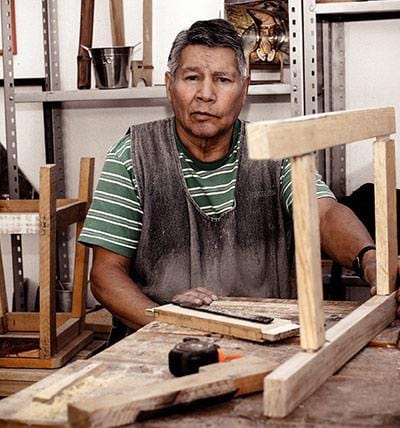A lot of people do wood coasters. We started over at the bandsaw and this is a Laguna 14b X and you want to make sure the entire piece clears. There is also the case where you get the cut started and then the very peak if it doesn't quite clear.
Here's another good tip: eight millimeters are the perfect cut point that makes a wood coaster thick enough. After it's all sanded it is not going to break on you, so eight millimeters is a good place to be.
We use a three-quarter inch carbide resawing blade though people tend to put a little bit thinner blades than this on their band saws. We find most of the cuts we make with this bandsaw are straight or pretty straight anyway. What we really like about the 3/4 inch is that you get to a really clean cut for tall resells like this. Realistically to make coasters like this you do need a bandsaw, but we would say you need a drum sander. It does help to get them a perfectly uniform thickness. So that's why we ran them through the drum sander. It will get just the right thickness and it will get this saw marks out.
Don't make the mistake of waitting to start sanding them till you get them to the final size. So what you have to do here is to sand everything to 180 grit, while they're in as big a piece as possible. That's gonna save you from having to hold tiny little coasters in my hand and sand one at a time. If you're curious with this funny-looking devices, it's a Festool vacuum clamp. It's pretty handy. It's definitely not necessary for something like this. What we also used to use is just a rubber pad set on the workbench that you stand on and that kind of keeps the vibrations down. So we really just recommend using a rubber pad for this type of work, but the vacuum clamp is obviously pretty nice. You can play around with this different sizes of coasters.
Over the years of making these, we found that four inches is a good standard coaster. If you want to make kind of an excel one, maybe four beer steins, four and a half inches, but with the live edge. You're obviously gonna have some fluctuation there, so try to get everything to about four inches wide by roughly four inches with the live edge. About half the coasters done in this batch were perfectly square. In the other half were with the live edge. Here's some of the square ones and for no particular reason we did just a chamfer bit here. It's a 45 degree bit and just made the edge a little more interesting than rounding it over for the ones with the live edge.

You can go with a regular 1/8 inch roundover bit, which is kind of a default alternative to just hand sanding over a corner. The eighth inch gives you a nice uniform, rounded overlook that just looks more finished than doing it by hand.
Moving out of the finished process, we've used a lot of different finishes for these coasters, and this time we went with an armored seal. It's an urethane type finish and it's a wipe on finish, but it's not quite as easy as Osmo or Odie's oil can make and it does take a few coats. But these have had a lot of softer wood in there beacuse this is spalted maple and the spalted parts can be really soft. This does a nice job of penetrating and giving a really hard durable finish.
That's all "be nice" for these coasters. While we're passing to the hyper finish here we'll explain the process. We go with the first coat pretty heavy. You can even brush it on if you wanted, or you can wipe it on come back sand. It then apply a second coat and then, if necessary, third or fourth. These sanding sponges work really well, because they don't really scar the material, they just take off the the dust nibs and the little imperfections in there. So go through the whole thing and sand it with these sanding sponges. You don't have to use this exact type. Any of the ones at Home Depot are fine. Two, twenty three twenty grit. They get everything nice and flat and then apply the second coat.
After you blow them off with some compressed air. These microfiber towels are the best thing for getting all the last little bits of dust off of there. Then, just like the first coat, add the second coat. You can go a little bit lighter and kind of wipe off any excess. It will make it a little bit more uniform than the one you see here. This is a spalted wood, so it's absorbing differently, which means it will take a few more coats. So this piece was really nice, probably good after two coats. As mentioned here, this more solid pieces took three coats: the softest it took five coats like this one. The cool thing with wood is everything is so different. But the frustrating thing with wood is everything so different, like this kind of punky soft spalted maple, this one with some crazy colors. We're hoping some of you out there are reading this because you're looking for ideas on things to use your scrap wood for.
ABOUT THE AUTHOR
Fred Felton
Content Creator / Editor
Fred Felton is a copywriter, editor and social media specialist based in Durban, South Africa. He has over 20 years of experience in creating high end content. He has worked with some of the biggest brands in the world. Currently Fred specialises in the wooden arts and crafts space, focussing on innovative wooden product design. He is also a keynote speaker and has presented talks and workshops in South Africa.






